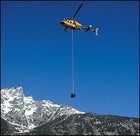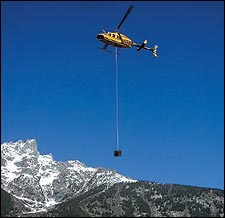THE JOHN AT 11,600 FEET on the Lower Saddle between the Grand and Middle Tetons in Grand Teton National Park is justly famous for its sublime view. It’s hidden behind a massive boulder on the windward side of what is often an intimidatingly windy col, and it faces southwest—the most frequent direction of storms. There is no roof, and the wooden walls are only slightly higher than your knee. More than once I have occupied this throne in a 60-mile-an-hour wind, squinting at sheets of stinging graupel and dreading the halos of electric fuzz surrounding the bolts that hold together the bombproof edifice. The experience is always…well, gripping.
Pickup Games
Optional take-it-out policies are cropping up in our parks—but will anyone volunteer? A park service chopper hoists a honey bucket out of the Tetons.
A park service chopper hoists a honey bucket out of the Tetons.
There is a reason for the absence of a roof: It provides easy access to a toilet that embodies a mindset of convenience that is scarring the Saddle and disturbing its wildness. When the outhouse’s honey buckets are full, the National Park Service removes them by helicopter. In the mid-1970s, when the park began using choppers for the job, there were two flights per summer to carry out the 50-gallon buckets. By the summer of 2001, ten flights were carrying out three 60-gallon barrels. The risk of something going wrong increased proportionally, as did climbers’ complaints about the noise deep within an area that is supposed to be managed as wilderness. Once, during a similar operation in Rocky Mountain National Park, a cable snapped and the bucket dumped some of its load. Needless to say, climbing rangers are not fond of what is scatalogically known as the shit shuttle.
If you add to the Teton john cat holes, rock smearing, and other waste-disposal variations used on the Saddle, the situation, as in many other areas in our national parks, has become a stinking mess. And yet the john represents a bit of tradition at a time when bits of tradition are disappearing at an alarming pace. For teens especially, a snapshot on the throne with most of Idaho in the background is as coveted as a photograph on the summit of the Grand. But with 5,000 climbers camping in a limited spot each summer, something had to change.
In September 2001, Al Read, president of Exum Mountain Guides, put forth a radical policy, one that is gaining support in national parks across the country. In a meeting with Grand Teton officials, he suggested that everyone be responsible for packing their own excrement off the Lower Saddle. (Read says he made his decision based on “Leave No Trace” ethical and aesthetic reasons. But I also think the stench that wafts over the place on the long dog-day afternoons of August influenced my old friend.) The park agreed, and over the winter it considered various waste-disposal systems before deciding on RESTOP 2, an affair involving a zip-sealing plastic bag loaded with polymers and enzymes that rapidly convert solid waste into an odorless gel.
This year is a transition between the old ways and the new on the Grand Teton. Both Exum and Jackson Hole Mountain Guides require clients to use RESTOP 2. And what will become of the storied Teton john? The old two-holer behind the boulder will still be an option for non-guided climbers, at least for the near future.
The interesting question is why it’s taking mountaineers so long to get their shit together, as it were. How many years have we spent tiptoeing in the dark through fields of desiccated turds along, say, the Baltoro, or around base camps at nearly every important mountain in the world? Are we finally facing the reductio ad absurdum of the dirt-bag ethic, or are these dung-filled wastes simply another example of self-interest versus a more tiresome greater good? Many popular alpine areas have been desecrated to the point of being vile, and no one seems to care. Although I will miss the old john on the Lower Saddle, if and when it goes, I will not miss the deafening helicopter in the wilderness—or the stench of those dog-day afternoons.


